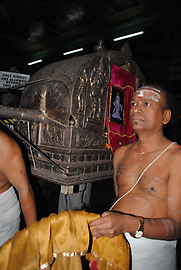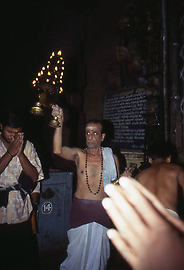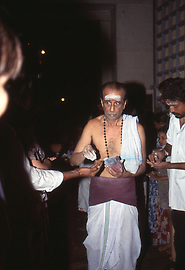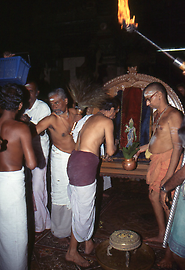The temple of goddness Minakshi, Shivas wife in the most important pilgrimage site in Madurai in Southern India#
Gigant and confusing world of gods and a very human ceremony#
By
All photos are taken by the author of this essay from his archive „Pictureflood".
It is rather rare that goddesses whose legend is connected to only one particular place, have their own temple district. This is the case in an area located in Madurai Indien, Madurai in the federal state of Tamil Nadu in southern India. In the Hindu pantheon, the goddess Minakshi is the sister of the high god Vishnu. In the presence of all gods, she is married to the powerful Shiva and therefore is considered to be a manifestation of his main wife Parvati.
She receives the war god Karttikey from Shiva. Karttikey is also known under the name Subhramanya or Kumara, the Tamils call him Murugan. He is mainly worshipped by Hindus in southern India.



In illustrations, the goddess is depicted with her green skin colour and a parrot on a flower bouquet as attribute.
The name Minakshi sounds strange. In Sanskrit, it means fish-eyed. Like fishes with longish eyes, almond-shaped eyes were regarded as an ideal of beauty in old India. Thus, she does not gaze cold like a fish, but is a woman with an especially beautiful and attractive face. Being also the patron god of fishermen, there is evidence that she turned from a locally worshipped goddess to a higher rank as the interpretaion of Shiva‘s further wife. This would have happened at a time, when the already developed Hinduism in northern India reached the southern part. In connection with Minakshi, Shiva is always called Sundareshvara (the beautiful man).
In myths, Shiva is also called Nataraja „King of Dance“. In a circle of flames, he is dancing as ascetic the cosmic dance Tandava. The energy produced this allows stars to continue to circulate and the sun to shine. With his feet, he is stamping down the demon Apasmara, who personifies stupidity and ignorance. Shiva has four arms. With one hand he shows the gesture „grant of protection“ (abhayamudra). He has an hourglass drum of an ascetic in the other hand. This kind of illustration emerged approximately in the year 1000 in southern India. Beautiful examples of this using the art of bronze casting can be admired in the temple of Minakshi in Madurai.

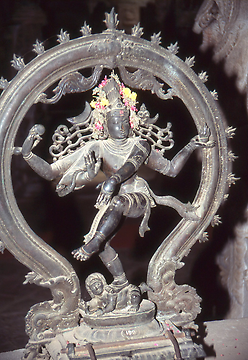
The temple connected with Minakshi’s name and dedicated to her is the most splendid example of Dravidian architecture. The entire temple district covers an area of approximately six hectares. A separate subcaste of Brahmins serve as priests for liturgical service at the numerous ritual actions. Another subcaste of servants are supporting them. There are approximately 60 priests and 20 servants. They are dressed in white. As members of the highest caste, they are entitled to wear sacrificial cords (yagnyopavita).
Visitors enter the temple through one of its 12 gate towers (gopuram „cow town)), the highest and most splendid is the east Gopuram which is plated with hundreds of life-size and colourfully painted sculptures. The oldest parts of the temple date from the 13th century. The present appearance of the temple is feom to the kings of the Vijayanagar dynasty. Right here, the kings appointed a governor (nayak) whose palace is a further attraction of Madurai.
The East-Gopuram is the highest of all. Today, climbing this Gopuram is forbidden. Again and again, people committed suicide by jumping from the tower.

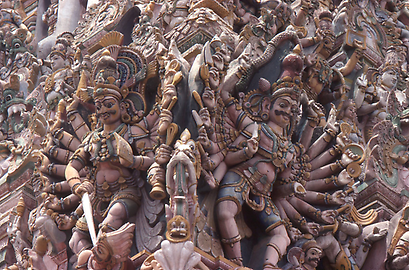

Wenn nach Jahrzehnten die Regengüsse der Monsunzeit die grellbunten Farben verbleichen hatten lassen, werden diese wieder erneuert und der Gopuram erstrahlt in neuem Glanz.
Over decades of heavy rain in the monsoon season, the colours are fading. Then the Gopuram is newly painted to return to its former splendor.
Minakshi and Shiva have golden shrines with a picture of God, respectively, protruding from the maze of long corridors, including one with thousand pillars. The temple can be visited in most of its parts. However, the innermost areas and the shrines are sacrosanct and only Hindus have the right to enter. \
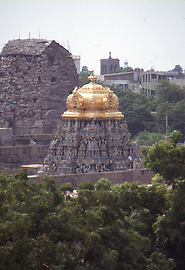

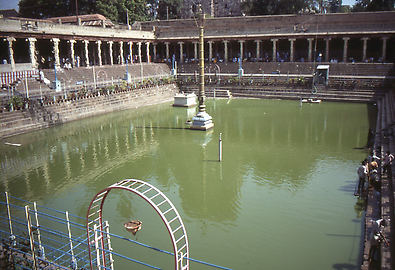

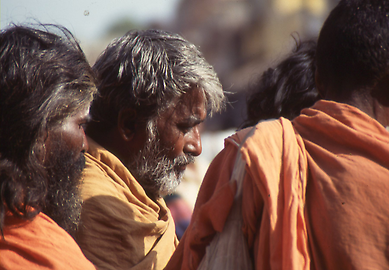




Like in the classical antiquity in Europe, India’s Gods have very human-like traits. They have the same needs as humans and they are given revered offerings that can be virtually tasted. They are bathed and their sense of smell is pleased by incense sticks. At daytime, Minakshi and her husband Shiva/Sundareshvara are worshipped in their golden shrines. When night is approacheing, they are offered to enjoy their married life. Brahmin priests and temple servants carry the cult image of Minakshi, shielded from profan eyes, from her shrine in a magnificent litter to her husband’s shrine. They will now spend the night together until the next morning.



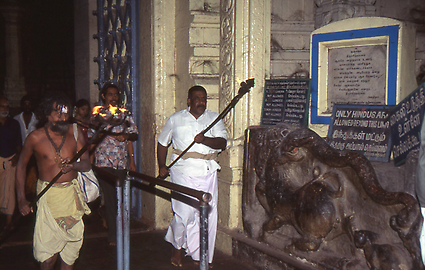



The litter is placed on a Mandala (meaning circle in Sanscrit, spiritual and ritual symbol)that is elaborately painted with chalk on the floor. A big fan produces air for the hidden goddess. The curtain hiding the goddess shows the aniconic figure of Shiva (showing only symbols in the absence of material representations), consisting of a stylized phallus (lingam).
Brahmins accompany the procession and the associated rites. Ash lines on their forheads attest that they are followers of Shiva.


